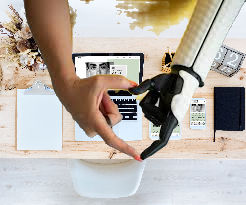What is Inclusive Design, anyways?
- Alicia Jarvis
- Apr 11, 2021
- 2 min read
Updated: Nov 5, 2025

“Everyone designs who devises courses of action aimed at changing existing situations into preferred ones.“ — Herbert Simon —
A few years ago, when I joined the digital design team at RBC, I was introduced to this quote by Herbert Simon, “Everyone designs who devises courses of action aimed at changing existing situations into preferred ones.“
One day during a workshop, a designer came up to me and asked “Are you a designer?”. I stumbled over my words and probably gave the most cliché and quintessential answer a designer could give. I replied, “Well that’s a great question…I don’t know, Am I a designer?”.
After that day, I did some deep thinking, completed a few design courses, and finally sat down and read a few books, including: Mismatch: How Inclusion Shapes Design by Kat Holmes and Authentic Inclusion™ Drives Disruptive Innovation by Frances West. Although, it took me some time to process, I realized that I may not have gone to design school, but I’m definitely a designer!
You see, I was born into a world that was not designed for me; so, I’ve had no choice but to devise courses of action aimed at changing existing situations into something that works for me.
Throughout the course of my career, here’s what I’ve learned about the difference between Inclusive Design and Accessibility in a nutshell:
Inclusive Design is design that considers the full range of human diversity with respect to ability, language, culture, gender, age and other forms of human difference.
Whereas, Accessible design is a design process in which the needs of people with disabilities are specifically considered.
The bottom line here is that we need to be intentional about an intersectional approach that thinks beyond just the right of access. Considering disability without considering other forms of human diversity is fundamentally doing a disservice to not only the practice of design, but also the people we are serving.
My cultural background, race, age, level of education, location, gender, sexual orientation, and socio- economic status all equally contribute to and shape the ways in which I experience the world. As designers, it is our responsibility to ensure that no one ever feels like they are speaking on behalf of an entire group of people.
“Does My Product/Service Have To Be Inclusive?”
In my line of work, I often get asked “…But do we really have to” and my answer is always the same, YES! Imagine for a moment that instead of a digital product designer, you were the lead prosthetist at a clinic. One day, you see a young girl with short arms struggle to open the door because she can’t turn the door knob. You wouldn’t ignore her and keep fitting other child amputees with prosthetic limbs and say “meh, she has hands so she’s probably fine.”
As a good employee (and let’s face it, a good designer) you’d try your best to make sure she received the same level of service as any other client.
Throughout my life, I’ve had to constantly advocate and speak up for myself and others with disabilities. It’s exhausting and we, as designers, need to do better! Inclusive design is just good design, plain and simple.



Comments